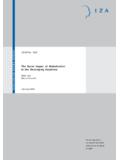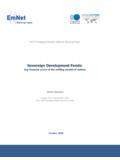Transcription of Comparative Analysis of Indian Stock Market with ...
1 Great Lakes Herald April 2007 Volume 1, Issue 1 by Great Lakes Institute of Management, Chennai 39 Comparative Analysis of Indian Stock Market with International Markets Debjiban Mukherjee T. A. Pai Management Institute, Manipal, India Abstract The Stock Market is witnessing heightened activities and is increasingly gaining importance. In the current context of globalization and the subsequent integration of the global markets this paper captures the trends, similarities and patterns in the activities and movements of the Indian Stock Market in comparison to its international counterparts. This study covers New York Stock Exchange (NYSE), Hong Kong Stock exchange (HSE), Tokyo Stock exchange (TSE), Russian Stock exchange (RSE), Korean Stock exchange (KSE) from various socio-politico-economic backgrounds.
2 Both the Bombay Stock exchange (BSE) and the National Stock Exchange of Indian Limited (NSE) have been used in the study as a part of Indian Stock Market . The time period has been divided into various eras to test the correlation between the various exchanges to prove that the Indian markets have become more integrated with its global counterparts and its reaction are in tandem with that are seen globally. Keywords: Stock Market , Comparative Analysis , Statistical Analysis , Efficiency Test. Great Lakes Herald April 2007 Volume 1, Issue 1 by Great Lakes Institute of Management, Chennai 40 1. Introduction The Indian Stock exchanges hold a place of prominence not only in Asia but also at the global stage. The Bombay Stock Exchange (BSE) is one of the oldest exchanges across the world, while the National Stock Exchange (NSE) is among the best in terms of sophistication and advancement of technology.
3 The Indian Stock Market scene really picked up after the opening up of the economy in the early nineties. The whole of nineties were used to experiment and fine tune an efficient and effective system. The badla system was stopped to control unnecessary volatility while the derivatives segment started as late as 2000. The corporate governance rules were gradually put in place which initiated the process of bringing the listed companies at a uniform level. On the global scale, the economic environment started taking paradigm shift with the dot com bubble burst , 9/11, and soaring oil prices. The slowdown in the US economy and interest rate tightening made the equation more complex. However after 2000 riding on a robust growth and a maturing economy and relaxed regulations, outside investors- institutional and others got more scope to operate.
4 This opening up of the system led to increased integration with heightened cross-border flow of capital, with India emerging as an investment hot spot resulting in our Stock exchanges being impacted by global cues like never before. The study pertains to Comparative Analysis of the Indian Stock Market with respect to various international counterparts. Exchanges are now crossing national boundaries to extend their service areas and this has led to cross-border integration. Also, exchanges have begun to offer cross-border trading to facilitate overseas investment options for investors. This not only increased the appeal of the exchange for investors but also attracts more volume. Exchanges regularly solicit companies outside their home territory and encourage them to list on their exchange and global competition has put pressure on corporations to seek capital outside their home country.
5 The Indian Stock Market is the world third largest Stock Market on the basis of investor base and has a collective pool of about 20 million investors. There are over 9,000 companies listed on the Stock exchanges of the country. The Bombay Stock Exchange, established in 1875, is the oldest in Asia. National Stock Exchange, a more recent establishment which came into existence in 1992, is the largest and most advanced Stock Market in India is also the third biggest Stock exchange in Asia in terms of transactions. It is among the 5 biggest Stock exchanges in the world in terms of transactions volume. Great Lakes Herald April 2007 Volume 1, Issue 1 by Great Lakes Institute of Management, Chennai 41 Origin of various Stock exchanges: The origin of the New York Stock Exchange (NYSE) is dated back to May 17, 1792, when the Buttonwood Agreement was signed by twenty-four Stock brokers outside of 68 Wall Street in New York under a buttonwood tree.
6 Also called the Big Board , it is the largest Stock exchange in the world in terms of dollar volume and second largest in terms of number of companies listed. The Tokyo Stock exchange was established on May 15, 1878 and trading began on June 1, 1878. In 1943, the exchange was combined with ten other Stock exchanges in major Japanese cities to form a single Japanese Stock Exchange. It is the second largest Stock exchange Market in terms of monetary volume and currently has 2302 listed companies. The Hong Kong Stock exchange is the 8th largest Stock exchange in the world in terms of Market capitalization. The Hang Sang Index (HIS), was started on November 24, 1969. The Russian Stock exchange was established in 1995 by consolidating the separate regional Stock exchanges into one uniformly regulated trading floor. The Korea Stock exchange was created by the integration of the three existing of the Korean Spots and Futures exchanges (Korean Stock exchange, Korean futures exchange & KOSDAQ) under the Korea Stock and Futures Exchange In this paper, the names of the countries and the names of the indices of those countries have been used interchangeably.
7 Thus, the names of the countries represent the indices for the purpose of Analysis and they need to be interpreted that way. Again, all the analyses have been done with the closing prices. The following table gives the country and the exchange with the name of its indices. Country Stock exchange name Indices name India National Stock Exchange S & P Nifty India Bombay Stock Exchange Sensex Hong Kong Hong Kong Stock Exchange Hang Seng USA New York Stock Exchange NYSE Korea Korean Stock Exchange KRX 100 Russian Russian Stock Exchange RTS Index 2. Past Studies Poshakwale, Sunil (2002) examined the random walk hypothesis in the emerging Indian Stock Market by testing for the nonlinear dependence using a large disaggregated daily data from the Indian Stock Market . The sample used was 38 actively traded stocks in the BSE National Index. He found that the daily returns from the Indian Market do not conform to a random walk.
8 Daily returns from most individual stocks and the equally weighted portfolio exhibit significant non-linear dependence. This is largely consistent with previous research that has shown evidence of non-linear dependence in returns from the Stock Market indexes and Great Lakes Herald April 2007 Volume 1, Issue 1 by Great Lakes Institute of Management, Chennai 42 individual stocks in the US and the UK. Noor, Azuddin Yakob, Diana Beal and Delpachitra, Sarath (2006) studied the Stock Market seasonality in terms of day-of-the-week, month-of-the-year, monthly and holiday effects in ten Asian Stock markets, namely, Australia, China, Hong Kong, Japan, India, Indonesia, Malaysia, Singapore, South Korea and Taiwan. He concluded that the existence of seasonality in Stock markets and also suggested that this is a global phenomenon.
9 Linkage patterns: Masih, Abul and Masih, Rumi (1997) examined the dynamic linkage patterns among national Stock exchange prices of four Asian newly industrializing countries - Taiwan, South Korea, Singapore and Hong Kong. The sample used comprised end-of-the-month closing share price indices of the four NIC Stock markets from January 1982 to June 1994. They concluded that the study of these markets are not mutually exclusive of each other and significant short-run linkages appear to run among them. Lau, S T and Diltz, (1994) studied the transfer of information among Tokyo and New York Stock exchanges. Agarwal, R N (2000) examined the financial integration of capital markets in developing nations gave insight with regards to the methodology and the area of study followed. In a similar study by Bae, K, Cha, B, and Cheung, Y (1999) the researchers tried to show the information transmission mechanism that operates for stocks which are dually listed.
10 This has helped in understanding the channel of transmission of information that makes the exchanges dependant on each other. 3. Problem Presently, the fluctuations in the Indian Market are attributed heavily to cross border capital flows in the form of FDI, FII and to reaction of Indian Market to global Market cues. In this context, understanding the relationship and influence of various exchanges on each other is very important. This study that compares global exchanges which are from different geo-politico-socio-economic areas. With the cross border movements of capital like never before in the form of FDI and FII, coupled with the easing of restrictions bringing various Stock exchanges at par in terms of system and regulations, it can be assumed reasonably that a particular Stock exchange will have some impact on other exchanges. 4. Objectives The main objective of this study is to capture the trends, similarities and patterns in the activities and movements of the Indian Stock Market in comparison to its international counterparts.









